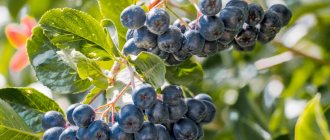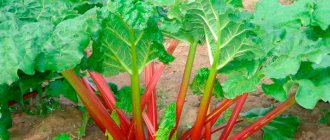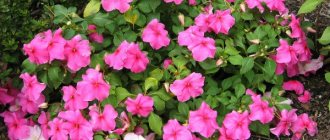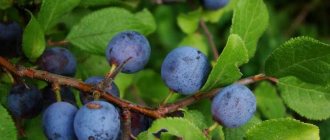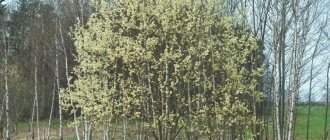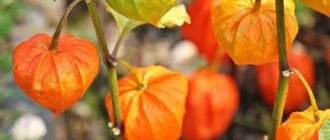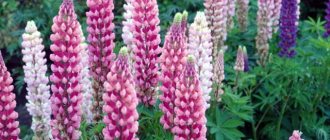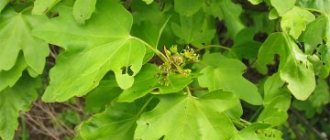Even if you are not going to grow rowan as a fruit tree, this crop may interest you as a decorative one, serving as a decoration for the site. In addition, its bright scarlet berries, sometimes remaining on the branches until the next season, serve as an excellent help for wintering birds, which happily feast on them in the absence of other food.
Common rowan is one of the most common types of rowan. It grows wild in Europe, Siberia, Asia Minor, and North Africa. Found singly or in groups in the undergrowth of deciduous, coniferous or mixed forests. Rowan has many varieties with large, sweet fruits (Nevezhinskaya, Moravskaya), and long weeping branches.
How to plant rowan, how to care for it and how to use it is described in detail on this page.
Features of the rowan tree
The duration of the plant's growing season is from 80 to 200 years. It usually grows as a tree or shrub no higher than 10 m, but in mountainous areas low-growing specimens can also be found.
The crown has a dome shape. The bark is yellowish-gray or brownish, shiny and smooth. The leaf blade of an adult tree is 20 cm long and includes 7–15 oblong leaves with a serrated edge. In summer the foliage is green; in autumn its color turns golden-red.
Flowering period is late May and early June. Whitish small flowers are united in lush inflorescences, the diameter of which is about 12 cm. The berries ripen in the last days of August or in the first weeks of September. They are represented by juicy orange or red apples with a tart, sweetish taste. Inside them are small round seeds.
How to plant rowan?
Modern rowan varieties easily adapt to growing conditions. The bushes tolerate partial shade well and are not afraid of short-term seasonal soil flooding and drought. However, under frequent exposure to negative factors, the decorative properties of the plant and productivity may suffer. That is why it is important to follow the timing and rules of planting, choose the location wisely and care for it in accordance with the requirements of agricultural technology.
When is the best time to plant?
When thinking about how and when to plant rowan, you should take into account that it wakes up somewhat earlier than many fruit crops. In spring, young plants are planted at the very beginning of the season, as soon as the snow melts. If you plan to plant rowan in the spring, you need to prepare the holes in the fall.
On a note! In warm regions, autumn planting is also practiced; for this purpose, the period of leaf fall is chosen.
Selecting a location
Areas in the eastern or northeastern part of the garden are well suited for rowan bushes. The culture likes to bathe in the rays of the morning sun; it tolerates openwork shade well during a hot day. At the same time, for the yield of fruit varieties, it is better to choose a place with a southern orientation.
Attention! Avoid lowlands, swampy, salty areas, as well as hills with too dry soil.
If tall varieties of rowan are selected, it is advisable to allocate a place on the border of the site, taking into account the life expectancy of the plant. Otherwise, after a few seasons, the garden plantings in the neighborhood will suffer in the shade of overgrown trees.
Soil preparation and planting
The culture is undemanding to the composition of the soil. It adapts relatively easily to various environmental conditions, but will grow better in fertile soils with good aeration.
Nuances of preparing the planting pit:
- for tall forms, dig a pit with dimensions of depth and width of 0.8x1 m, for shrubs and low-growing varieties - 0.6x0.8 m;
- add 1.5-2 buckets of rotted manure, 0.8-1 kg of superphosphate, 0.1 kg of potassium sulfate;
- add earth and mix thoroughly.
If it is planned to plant rowan in the spring, after the snow melts, part of the prepared soil mixture is poured into the hole, the plant is lowered, covered with substrate and lightly compacted. The seedling is buried so that a slightly larger part of the root collar is under the soil than it grew in the nursery.
Planting rowan in open ground
The tree survives frosts well and does not react to shade. Therefore, it can be cultivated in both shaded and sunny places, preferably moist. The rowan tree does not welcome weeds, as well as dense compaction of the soil around the trunk. Prefers cultivation on loams and sandstones.
One-year or two-year-old seedlings are suitable for planting in open areas. They grow quickly, so you can plant them in early spring or mid-autumn. The planting hole must correspond to the size of the root part of the tree. Its diameter on average ranges from 0.5–0.7 m, and its depth – 0.6–1 m. The distance between seedlings should be at least 5 or 6 m.
At the bottom of the planting hole you can put:
- 8–9 kg of humus;
- 0.4–0.5 kg of superphosphate;
- 80–120 g potassium salt;
- 15–25 cm layer of crushed stone for drainage.
After planting and compacting the earth, the root isthmus of the tree should be at ground level.
Choosing a growing location and planting instructions
Without pruning, rowan grows into a very tall tree, and therefore it should be planted on the border area of the garden area, so as not to shade the garden plantings with its rather spreading crown. The plant can be grown in almost any soil, but, like all representatives of the flora, it prefers fertile - medium loamy soil that can retain moisture and at the same time not form stagnation of water at the roots.
It is advisable to purchase a seedling from a specialized nursery or from well-known private traders in order to be sure of the purity of the chosen variety and the health of the plant. Before purchasing, the sprout should be carefully examined for mechanical damage, signs of pest attack and possible fungal diseases.
- The root shoots of a healthy tree are always flexible and not overdried. A two-year-old seedling should have 3 main strong shoots fully formed, from which small roots develop.
- The green part of the rowan tree must not contain stains or signs of insect pests. This is important, since a diseased seedling may not only fail to take root in a new place, but also infect trees and shrubs growing in the garden.
- Any mechanical damage to the branches indicates that the plant is weakened and will spend some of its energy restoring the integrity of the tissues of the shoots and branches. There is a possibility of poor rooting in the area.
Rowan berries are planted either in early spring - in April, or in autumn - after leaf fall. The weather should not be sunny, preferably cloudy. Immediately before starting the procedure, it is recommended to lower the root system of the seedling into a container with a preparation diluted in water to stimulate root formation. These could be Kornevin or Epin, which have especially proven themselves among gardeners.
Trees are usually planted several at a time, maintaining a distance of 4–5 meters between them. The planting hole should be about 80 centimeters deep and in diameter. Filling occurs in layers: the first 7-10 centimeters are drainage - broken brick or gravel, the second layer is compost with the addition of wood ash, 30 grams of superphosphate, then 5-7 centimeters of fertile soil with humus.
The seedling is carefully placed in the prepared hole, its roots are spread over the surface of the last layer of soil. The remaining volume of the depression is covered with earth, carefully compacting it with your hands so as not to damage the root system.
Tamping is very important to ensure that air bubbles do not form in the future at the depth of the pit. They promote rotting of the roots, as a result of which the plant will become sick and may completely die.
Upon completion of the planting of the seedling, a trunk circle is formed around its trunk. The plant is watered abundantly and mulched with sawdust to retain moisture and prevent cracking of the surface layer of soil. In addition, the central branch is shortened by 1/4 of the total length in order to activate the development of side shoots next year.
Rowan care
Caring for a newly planted seedling includes:
- Regular watering.
- Trimming broken branches.
- Digging up the earth around a tree.
- Fertilizer (starting from the third or fourth year).
- Treatment of diseases.
- Destruction of pests.
Diseases and pests
Signs of disease usually become pronounced in May or June. The plant is susceptible to:
- powdery mildew;
- anthracnose;
- gray spotting;
- ring mosaic;
- scab;
- necrosis.
Weakened trees are prone to disease. A healthy seedling that is properly cared for is extremely rarely affected by them. It is necessary to regularly inspect trees in order to detect the disease in time and begin treatment. The last two diseases are incurable. Therefore, great attention must be paid to pre-planting soil preparation.
The greatest damage to rowan is caused by birds feeding on its berries. In addition, pests include:
- bark beetles and sawflies;
- butterfly caterpillars;
- aphids;
- mole;
- ticks.
They are destroyed with chemical insecticides.
Care rules - pruning, fertilizing and pest protection
Caring for rowan trees in the garden consists of watering, seasonal pruning, fertilizing, loosening the trunk circle and treating against pests - these are the most basic procedures that are necessary for every plant grown in the garden. The culture does not require any additional care or attention from the owner.
Pruning and fertilizing the soil should be carried out in the spring at the first opportunity, because mountain ash awakens early after the winter period and resumes its development.
The principles of pruning depend on the age of the plant: in young trees, long thin shoots are shortened to the outer bud, and damaged fragments are cut off. The crowns of abundantly fruiting rowan trees are thinned out so that the sun's rays can easily illuminate and warm all parts of the tree, including the main trunk. To do this, all shoots growing inside the crown or crossing each other are removed or shortened to the outer bud. Branches whose growth is directed towards the ground are also pruned.
For mature trees whose growth has significantly weakened, rejuvenating pruning is performed. To stimulate the growth of young shoots, all poorly fruiting branches older than 4–5 years are carefully cut off.
Of course, it is necessary to cut off diseased parts of the plant that have frozen over the winter. Infected leaves and shoots should be burned immediately to prevent the disease from spreading throughout the garden. Places of cuts must be lubricated with garden varnish or oil paint based on drying oil - this will help the mountain ash quickly recover from damage and protect against infections.
After the tree reaches 3 years of age, you can begin to feed it with mineral fertilizers. This is done three times a year: before spring flowering, in summer and after picking berries. The selected products are shallowly embedded in the soil while loosening, then the rowan is watered abundantly.
Important! An interesting plant is the mountain ash. Read the article at the link.
So, in the first half of April it will be useful to add 20 grams of nitrogen, 25 grams of phosphorus and 15 grams of potassium fertilizers per square meter to the soil. To do this, you can use products such as superphosphate, urea, potassium salt or other preparations that are preferred by a particular gardener. In July, the dosage of each mineral is reduced to 10 grams, and in the fall only phosphorus and potassium are added - 10 grams each. Nitrogen during this period will be inappropriate and can even cause harm, as it activates the growth of the green part of the plant, which is unacceptable before frost.
Rowan positions itself as a crop that is quite resistant to diseases and pests, but in some years it can also be attacked by sawflies, caterpillars, mites, ants or rowan moths. If signs of the disease appear, regardless of the season and the presence of flowers on the branches, it is recommended to immediately cut off all damaged fragments and burn them. The tree itself should be sprayed with a solution of nicotine sulfate and ordinary laundry soap.
Types and varieties of rowan with photos and descriptions
About 90 species of mountain ash have been found in nature. Some are grown for harvest, while others are grown for decorative purposes.
Rowan elderberry sorbus sambucifolia
This tree is common in the Far East. It is a bush up to 2 m tall. The berries reach 1.6 cm in diameter, are juicy, have a sweet and sour taste and a pleasant smell.
Rowan glogovina sorbus torminalis or medicinal bereka
It grows in the Caucasus Mountains, on the Crimean Peninsula, in Turkey and in the southern regions of Ukraine. It grows in small groups or individual trees reaching 20 meters in height. The bark is dark grayish, covered with longitudinal cracks. The fruits are orange or light red, growing up to two centimeters in diameter, gradually changing color to brownish. Does not tolerate long absences of rain.
Rowan sorbus domestica or large-fruited Crimean rowan
It grows slowly, reaching a height of 16 meters. The berries grow up to 3 cm in cross section, are colored red, yellowish-greenish or brownish, have a tart-sweet taste, and contain stony inclusions. Resistant to prolonged absence of moisture and harmful insects.
Rowan roundleaf sorbus aria or aria or mealy rowan
Grows in mountainous areas. Young leaves are felt-white, but as they grow they turn green, and in the fall they take on a bronze color. The spherical berries are sweet and sour, up to 1.7 cm in diameter, their color is pinkish or reddish-orange. Its garden subspecies are known:
- Chrysophylla;
- Majestic;
- Decaysne;
- Manifika;
- edible.
Hybrid rowan sorbus x hybrida
The plant is the result of crossing two species of trees. The Thuringian variety, bred by hybridizing red rowan with round-leaved rowan, is popular among gardeners.
Common red rowan
The most common type of plant, which has a long list of decorative subspecies that serve as decoration for the surrounding landscape throughout its growing season. Trees differ in the shape of their crowns, shades of leaves and berries. Among the decorative forms of the plant, the most famous can be mentioned:
- Moravian (sweet);
- pyramidal;
- Burka;
- liqueur;
- Beisner;
- Michurinskaya dessert;
- pomegranate;
- Fifeana;
- Russian;
- crying.
The best varieties of red rowan
The most popular varieties are:
- Solar;
- Titanium;
- Shimi Glow;
- Germins;
- Fastigiata;
- Sorbinka;
- Wefed;
- Red Type, etc.
Rowan in landscape design
These trees are often used to decorate the landscape. They look great both isolated and in combination with other fruit and berry plantings. In autumn, they will stand out very favorably with their brightness against the background of monochromatic coniferous crops.
Weeping plant species can be used to decorate arches or gazebos. And with the help of shrub forms planted along the fence, a rowan hedge diluted with flowers will look beautiful. Rowan will highlight the beauty of red viburnum, rose, barberry and bird cherry growing nearby.
How to grow rowan?
This genus of woody plants of the Apple tribe has more than 80 species, including the common or red rowan (Sorbus aucuparia). Weeping forms often decorate garden gazebos, and thickets of branching shrubs make a hedge of incredible beauty. Red-orange rowan berries will be an attractive food for birds in winter.
On a note! A vitamin drink made from rowan berries is useful for kidney and liver diseases, and chokeberry contains a large amount of vitamin P and iodine.
The culture is easy to care for and is highly frost-resistant. It is grown from seedlings; gardeners also practice propagation of rowan by seeds at home. To breed varietal specimens, cuttings and grafting are used. Agricultural technology includes watering and fertilizing, pruning and protection from diseases and pests.
Properties of rowan: harm and benefit
It should be noted that this culture is not only very attractive, but also necessary for human health.
Useful properties of rowan
Almost all parts of the tree can be beneficial in the treatment of many diseases: berries, greens, bark and flowers. A decoction of the bark reduces blood pressure; infusions of fruits and flowers have found use in the fight against colds, digestive disorders and metabolic disorders. A tincture of rowan leaves is prescribed for scurvy - it has been found that they contain a lot of vitamin C.
The berries have the following healing effects:
- blood-forming;
- diaphoretic;
- healing wounds;
- relieving swelling;
- bile and diuretic.
Taking rowan juice orally is good for atherosclerosis, diseases of the circulatory system, rheumatism and gout. It has a healing effect when it is lubricated on skin wounds, warts and burns.
How to propagate rowan?
Various methods are used for this:
- propagation of rowan by seeds. This option is in demand when working with species samples;
- cuttings You can use green cuttings or blanks from the lignified part of the branch;
- graft. In the summer, rowan is propagated by grafting through a dormant bud;
- shoots. Own-rooted varieties are mainly propagated using suckers;
- layering. The method is suitable if the mother plant is a shrubby form.
Often propagation of valuable varieties of mountain ash is carried out using grafting in the cold season and even in winter. It is advisable to use wild plants as rootstocks, since they usually have a powerful root system.
Seeds
As practice shows, with the generative method of propagation, seedlings grow faster than cuttings or seedlings.
When thinking about how to grow rowan from seeds at home, consider the following nuances and recommendations:
- Rowan seeds can be sown in autumn or spring;
- In autumn, seeds are removed from ripe berries and stored in sand. At the end of the season they are planted in the ground, embedded to a depth of 7-10 mm;
- if you plan to propagate rowan by seeds in the spring, the sowing material can be stored in dry sand for 1-2 months at room temperature. 2-3 months before planting, the seeds in a container with sand are sent to the bottom shelf of the refrigerator for stratification.
The seedlings are watered in a timely manner, protected from weeds, and planted out at the end of the season. Young rowan seedlings grown from seeds are grafted at 3-4 years of age.
Cuttings
It is worth knowing that with this method of propagating mountain ash using green cuttings, the survival rate of specimens is about 50-60%. When using blanks made from lignified branches, the effectiveness drops to 40%.
Nuances of rooting:
- planting material - green rowan branches - is harvested at the beginning of summer;
- Cuttings 10-15 cm long with several promising buds are cut from the stems;
- for better rooting, a school with a top layer of sand at least 10 cm thick is used;
- until signs of development appear, rowan branches should remain under film cover;
- With proper planting and care, which consists of timely watering and ventilation of young plantings, you can soon observe the first buds blooming.
Knowing how to grow rowan from a branch, at the end of summer the rooted specimens are transplanted to a permanent place.
By layering
Only one-year-old shoots are used if rowan propagation is planned by layering.
Sequence of work:
- In spring, young branches are bent to the ground, having previously constructed grooves in proportion to the base of the bush.
- The entire length of the stem is fixed with staples, sprinkled with soil, the top is pinched to stimulate root formation and the formation of sprouts, and the substrate is moistened in a timely manner.
- Young shoots emerging from the buds in the 10 cm phase are mulched with humus, and repeated at a height of 15 cm.
- By winter, young animals are insulated with humus or spruce branches.
In spring, the plants are separated from the mother bush and transplanted to a permanent place.
What can be vaccinated?
The rowan tree has a lot of attractive characteristics for a rootstock and is in demand in amateur experiments in growing fruit crops. The plant overwinters well at temperatures down to -50°C and is undemanding to soil structure. The use of this low-growing rootstock promotes an early and abundant harvest.
When thinking about what can be grafted onto red rowan, it is worth knowing that the crop’s compatibility indicators with chokeberry (aronia) are excellent, not bad with pear trees, and a little worse with apple trees. Hawthorn, serviceberry and dogwood also have good chances. However, grafting cherry and plum onto rowan gives extremely low results.
Grafting an apple tree onto rowan
Such a tandem is promising only for varieties of plum-leaved (Chinese) apple trees. If the experiment is successfully completed, the debut apple harvest can be harvested in 2-3 years.
On a note! As gardening enthusiasts note, several varieties of apple trees can be grafted onto one rowan tree.
Gardeners practice grafting apple trees onto rowan trees in the following ways:
- improved copulation - suitable if the thickness parameters of the rootstock and scion are comparable;
- into a split - a good option if the thickness of the crown of a rowan tree is 3 times wider than that of an apple tree cutting;
- for the bark - grafting onto rowan using this method is used if the Ø of the rootstock is significantly larger than the scion.
For grafting work, select the period when sap flow begins. However, apple tree cuttings are harvested at the end of winter, when the temperature is around -10°C.
Attention! Vaccination against rowan under 2 years of age is not recommended.
Pear
Not all varieties of pear are compatible with this rootstock; grafting Ussuri varieties onto rowan is considered effective. It is with their help that you can prepare a rowan bush in order to graft other pear varieties onto it. This works because during the period that the cutting of the Ussuri variety “lives” on it, the tree becomes more “tolerant” of pears, and will be able to allow less compatible varieties of the crop to grow on it.
To successfully graft a pear onto a rowan tree, and as a result get a strong (promising) bush, it is important to know that:
- In this case, the scion will develop faster than the rootstock; soon the crown of the pear becomes more massive than the rowan trunk. To avoid unpleasant consequences, it is necessary to install a support that will prevent the tree from collapsing;
- The photosynthesis products necessary for the grafted cutting are produced by the mother bush, therefore at least 25% of the vegetative mass must belong to the rootstock plant.
On a note! Before grafting, you need to remove some of the branches of the mother plant, otherwise they will suppress the pear.
When planning to graft a pear or other crop onto a rowan tree, you can look for a rootstock plant in the forest. As practice shows, the best specimens for experiments grow next to spruce and pine trees.


